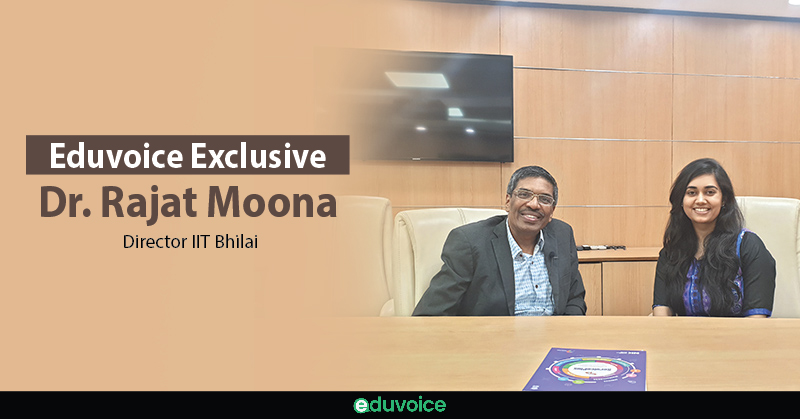Eduvoice exclusive interview

Rajat Moona
Director of IIT Bhilai
Professor of IIT Kanpur with teaching experience of over 25 years
In 2005, launched IIT Kanpur ID card system based on smart cards and called smardID. It was used and is operational even now.
introduction
A very informative conversation with Dr. Rajat Moona, director of the Indian Institute of Technology, Bhilai (IIT Bhilai), about the advancement of technology in education, the pros, and cons of technology and his personal experience with the changes in the higher education system.

Sujata Mehta
If I’m not wrong you are a person who loves to build systems and believes in developing technologies to make life easier. So, please share any such example you have initiated using technology for the management of education.

Dr. rajat moona
Yes, that is true. I had been one of the proponents of the online examination in IITs. The first time, online examinations were started was in 2010. Let’s first understand the concept of online examination.
Online examination in true sense is a computer-based examination as opposed to pen and paper-based examination and not necessarily “online” – as an internet-based examination.
In 2010, I was the GATE chairman for IIT Kanpur, and that was the first time to initiate this process of computer-based examination. I in 2010, GATE hosted 20 plus in various subjects and we conducted computer-based online exams for two papers.
The model that was developed by me and my team at that time is used nowadays in all entrance examinations across the country.
I was also a part of the JEE (Main) Apex board from 2011-14. During that time, we introduced computer-based examinations in a major way in JEE main. Today, I think the computer-based mode of examinations is very successful in these exams.
SUBSCRIBE TO OUR NEWSLETTER
For latest updates on Exclusive Interviews, News, Articles about Higher Education Industry

Sujata Mehta
Is the NPTEL similar to the SWAYAM service?

dr. rajat moona
IITs have done an excellent job of the National Program on Technology Enhanced Learning (NPTEL) which was started in 2003.
NPTEL as a program was used to deliver the recorded lectures either thorough websites or through YouTube, thus allowing students from all over the country to access those lectures to learn at their convenience.
NPTEL was only a platform for recorded lectures. With time, it was natural to build a complete MOOC based program – massive open online course, where other than recorded lectures things like learning management systems, examination systems and more were added to NPTEL to make it a tool for training and education including credits being given.
SWAYAM is a program built from the model of NPTEL. It came out of the technological developments and experiments that were done with IITs NPTEL

Sujata Mehta
Is there any such implementation of technology in the IIT Bhilai campus also?

dr. rajat moona
We at IIT Kanpur, including I, several students and staff members and a few faculty members have been the developer of the smart card programs in the country. Driving licenses, vehicle registrations certificates, BPL cards, coastal cards, and many other such cards came from the operating system which was developed under my supervision. It was conducted in my lab by students and today it has become a national standard and almost all projects are using this.
Based on this, we were able to create an attendance management system. So technically a smart card is a plastic card with a small chip that provides the authenticity of the information.
We implemented the ID card system using the same smart card mechanism in IIT Bhilai, which is used for student attendance, access to e-locks of the labs, as well as for small payment systems like library fines, etc.
Students will be able to use the same card to do small transactions within the campus. This promotes a cashless transaction system. All our staff members and students use it to mark their attendance.

Sujata Mehta
I’m very eager to know about the acceptance rate about new technology for both professors & students?

dr. rajat moona
Initially, everyone’s a little hesitant about the changes but as it happens people start liking it because the newer systems provide lots of features that earlier systems could not. I think originally the hesitation was because of the non-awareness of uses but now we are getting the demands of putting such locks on all the labs of the institution.
So the acceptance of this new system is very high and people are wanting these systems to be applied everywhere. I think as we are a new institute, the acceptance, in general, is higher here than already running established institutes.

Sujata Mehta
It always needs more courage to do something which is off the track. Like most of the people in the education sector are not technology prone. You must have faced challenges. What are they?

dr. rajat moona
The biggest challenge is the question, “What is the need for this change ?’ People often ask that if the existing system is already working what is the need of starting something new. As human beings, we are generally opposed to changes, and not very happy to adopt the changes. However, when the change happens and becomes much more effective than the previous system, we generally adapt to it and we like it.
“While changes are the only constants, in an academic institute change can also be a pain since they require time to stabilize.”
Second is the procurement of items and installation. Once in a while, we do get into roadblocks with existing processes because of incompatibility with the newer technology.
Next is the lack of awareness and expertise in the installation teams.
Lack of vendors is also a big challenge for us, as there is a lack of innovative technologies in the market.
And lastly, diverse perspectives about the changes is also a challenge.
For example, we are now implementing these systems to messes and hostels. Hostel messes are becoming huge, serving 300-400 students as regular subscribers and around 20-30 additional people, on per day basis. The mess workers find it difficult to identify people. To solve this issue, we are implementing a mess attendance system wherein the students will show their smart cards to the card readers.

Sujata Mehta
What are your suggestions for every educational institute & people associated who are not embracing technologies as a friend and stuck to the orthodox process?

dr. rajat moona
My only suggestion will be, anytime one has to move forward of technology adoption, it requires a bolder step because you are moving into a territory. Now, one shouldn’t be afraid of taking a bold step as without this one can not cross the threshold where one starts enjoying or start getting the benefits of that technology.
So, bolder steps are needed and to take a bold step, one has to be in full control of the process technology one has to understand, one has to be convinced about. Often, when they don’t get convinced they don’t want to take a bold step and therefore so they won’t want to invest efforts and resources in adopting the technology and discuss the impact that technology can create.
For example, we are in the midst of our campus construction and planning activities. An academic institution requires the construction of several buildings such as hostels, academic buildings, labs, etc. There will be multiple people involved in the construction process.
When so many people are involved in something it is virtually impossible to efficiently manage these people and manage the process without the application of information technology. Whether it is an architect, contractors, program management committee, project management agency, quality assurance, testing, etc. These are just too many people involved and if one doesn’t take advantage of technology the process can easily become very mismanaged.
“Understanding the technology, Employing the right people, making Dream or Vision that we want to do and then taking a bolder step to implement is the only solution to embrace technology”

Sujata Mehta
Please list 5 such technology for education management things you think everyone should implement?

dr. rajat moona
I think that there are several systems that one needs to have
- Learning management system (LMS) is primarily used for keeping records of students enrolled in courses, their academic performance, their exam results, their attendance records, etc. Developing a learning management system is very important and through this management system next level details like giving out handouts, home assignments, question papers, answer key, mode answers practice problems, etc can be managed. These kinds of facilities are part and parcel of modern LMS. One of the open-source LMS is Moodle. But there is much other software which are available for use – both in open source and in commercial space.
- Plagiarism Checker is another very important tool that allows professors to check the authenticity of reports, answers, and research. One such commercial tool is Turnitin, where professors can find out whether the material is copied or not, and if the material is copied one can take relevant action.
- Information Management System for Academic Records is perhaps the most important tool as the record keeper for the student grades in various courses, their time frames, management of course registration processes, approvals from various stakeholders, maintenance of course list registered for the students, timetabling, etc. Without this kind of information management system, it is virtually impossible to keep a track of more than five to six hundred students and more than a hundred classes per week. All academic records, degrees, diplomas, mark sheets, academic awards, etc. are managed by this piece of software.
- A human resource management system is for employees including the staff and faculty members which helps to keep track of promotion, salaries, leaves, and other important details related to HR. Investment in the system will always turn out to yield positive results.
- Public Relations management is becoming extremely important for academic institutes in current times and it includes management of social media networks, alumni networks and promotes the achievements and events of the institutes.

Sujata Mehta
Everything has its pros & cons. So far we are just discussing the pros, but there is a need to see another side of the coin. What are its cons during implementation?

dr. rajat moona
Actually, the biggest con I see is that technology has partially disconnected people in certain ways. We, these days, know many people on our network but we don’t know who they are since we might not have met them in person. So, we became disconnected in some sense while paradoxically remaining connected. A physical connection is important and there is nothing equivalent to a personal handshake. A person has a better chance of connecting when they deal in person rather than greeting people through messages and phone.
The second disadvantage I see is that the advent of technology has led to overconfidence and over reliability over technology in certain ways. Quick and easy access to information has led to a lot of procrastination among people because just the availability of information makes them confident to be able to refer to it anytime. This has become a big problem as often people don’t look at the information at the right time. High dependence on technology can have many disadvantages. Technology has benefits when used efficiently. If used properly, it can help a person in enhancing knowledge and productivity. People prefer using Google and Wikipedia for gaining knowledge since they have easy accessibility. Students are attracted to these websites since these platforms have provided them with ease of learning at their own pace and it would be beneficial to them, provided they use it without getting distracted. Technology, if not utilized properly, may/may not provide the desired results as it is important to engage students for making them learn and understand.
The third and biggest problem for us is that students do not know how to utilize social media properly for learning. More often than not the social media is being used for chatting, sending jokes, greetings, propagation of unverified information, etc. While students can also use social media for gaining and sharing knowledge in a major way.
Technology is an essential part of our lives now and people need to utilize it for beneficial purposes rather than for wasting time.
For More Such Articles, News Update, Events, and Many More Click Here.







